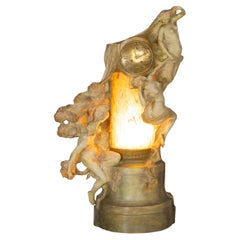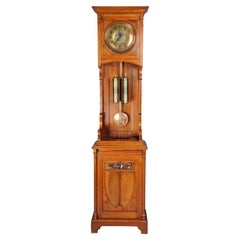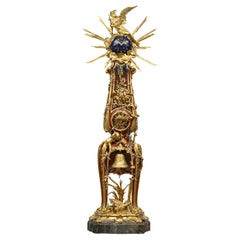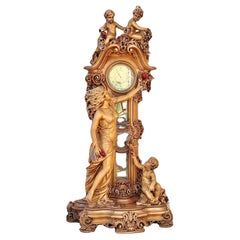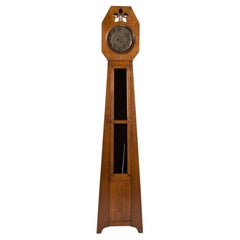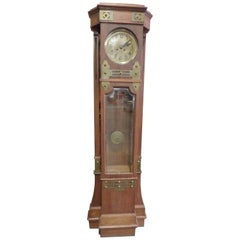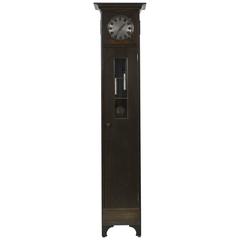Art Nouveau Longcase Clock
Antique 19th Century Austrian Art Nouveau Grandfather Clocks and Longcas...
Metal, Enamel
20th Century German Grandfather Clocks and Longcase Clocks
Mahogany
20th Century French Art Nouveau Grandfather Clocks and Longcase Clocks
Marble, Ormolu
Mid-20th Century Art Nouveau Grandfather Clocks and Longcase Clocks
Fruitwood
Early 20th Century French Art Nouveau Grandfather Clocks and Longcase Cl...
Oak
Recent Sales
Vintage 1910s French Art Nouveau Grandfather Clocks and Longcase Clocks
Oak
Antique Early 1900s German Art Nouveau Grandfather Clocks and Longcase C...
Oak
Antique Early 1900s Austrian Art Nouveau Grandfather Clocks and Longcase...
Chrome
Early 20th Century Austrian Art Nouveau Grandfather Clocks and Longcase ...
Brass
Early 20th Century Art Nouveau Grandfather Clocks and Longcase Clocks
Antique Late 19th Century French Art Nouveau Grandfather Clocks and Long...
Oak
Antique 1890s French Art Nouveau Grandfather Clocks and Longcase Clocks
Walnut
Early 20th Century German Art Nouveau Grandfather Clocks and Longcase Cl...
Brass
Early 20th Century French Art Nouveau Cabinets
Oak
Early 20th Century French Art Nouveau Cabinets
Oak
20th Century German Art Nouveau Grandfather Clocks and Longcase Clocks
Brass, Copper
Antique 1890s Art Nouveau Grandfather Clocks and Longcase Clocks
Oak
Vintage 1940s Unknown Baroque Grandfather Clocks and Longcase Clocks
Walnut
Antique Early 1900s American Art Nouveau Grandfather Clocks and Longcase...
Mahogany
Early 20th Century French Art Nouveau Grandfather Clocks and Longcase Cl...
Oak
Antique Early 1900s German Art Nouveau Grandfather Clocks and Longcase C...
Oak
People Also Browsed
Early 20th Century European Art Nouveau Vases
Bronze
Antique Late 19th Century French Rococo Mantel Clocks
Enamel, Ormolu
Antique 19th Century Persian Sultanabad Persian Rugs
Wool
20th Century French Floor Mirrors and Full-Length Mirrors
Beech
Early 20th Century Chinese Sculptures and Carvings
Coral
Early 20th Century English Victorian Daybeds
Walnut
Antique Late 19th Century French Louis XV Fireplace Tools and Chimney Pots
Bronze
Vintage 1930s American Art Deco Wall Clocks
Metal, Steel
Early 20th Century French Art Nouveau Planters, Cachepots and Jardinières
Ceramic
2010s Italian Modern Wall Lights and Sconces
Murano Glass
Antique 15th Century and Earlier Chinese Tang Sculptures and Carvings
Terracotta
Vintage 1960s American Mid-Century Modern Scientific Instruments
Metal
Antique Late 19th Century Russian Baroque Paintings
Gesso, Canvas, Giltwood, Paint
Vintage 1950s English Victorian Fireplaces and Mantels
Iron
Antique Late 19th Century Italian Chairs
Velvet, Wood
Antique 19th Century Italian Renaissance Lanterns
Wrought Iron
Art Nouveau Longcase Clock For Sale on 1stDibs
How Much is a Art Nouveau Longcase Clock?
A Close Look at Art-nouveau Furniture
In its sinuous lines and flamboyant curves inspired by the natural world, antique Art Nouveau furniture reflects a desire for freedom from the stuffy social and artistic strictures of the Victorian era. The Art Nouveau movement developed in the decorative arts in France and Britain in the early 1880s and quickly became a dominant aesthetic style in Western Europe and the United States.
ORIGINS OF ART NOUVEAU FURNITURE DESIGN
- Emerged during the late 19th century
- Popularity of this modernizing style declined in the early 20th century
- Originated in France and Britain but variants materialized elsewhere
- Informed by Rococo, Pre-Raphaelite art, Japanese art (and Japonisme), Arts and Crafts; influenced modernism, Bauhaus
CHARACTERISTICS OF ART NOUVEAU FURNITURE DESIGN
- Sinuous, organic and flowing lines
- Forms that mimic flowers and plant life
- Decorative inlays and ornate carvings of natural-world motifs such as insects and animals
- Use of hardwoods such as oak, mahogany and rosewood
ART NOUVEAU FURNITURE DESIGNERS TO KNOW
ANTIQUE ART NOUVEAU FURNITURE ON 1STDIBS
Art Nouveau — which spanned furniture, architecture, jewelry and graphic design — can be easily identified by its lush, flowing forms suggested by flowers and plants, as well as the lissome tendrils of sea life. Although Art Deco and Art Nouveau were both in the forefront of turn-of-the-20th-century design, they are very different styles — Art Deco is marked by bold, geometric shapes while Art Nouveau incorporates dreamlike, floral motifs. The latter’s signature motif is the "whiplash" curve — a deep, narrow, dynamic parabola that appears as an element in everything from chair arms to cabinetry and mirror frames.
The visual vocabulary of Art Nouveau was particularly influenced by the soft colors and abstract images of nature seen in Japanese art prints, which arrived in large numbers in the West after open trade was forced upon Japan in the 1860s. Impressionist artists were moved by the artistic tradition of Japanese woodblock printmaking, and Japonisme — a term used to describe the appetite for Japanese art and culture in Europe at the time — greatly informed Art Nouveau.
The Art Nouveau style quickly reached a wide audience in Europe via advertising posters, book covers, illustrations and other work by such artists as Aubrey Beardsley, Henri de Toulouse-Lautrec and Alphonse Mucha. While all Art Nouveau designs share common formal elements, different countries and regions produced their own variants.
In Scotland, the architect Charles Rennie Mackintosh developed a singular, restrained look based on scale rather than ornament; a style best known from his narrow chairs with exceedingly tall backs, designed for Glasgow tea rooms. Meanwhile in France, Hector Guimard — whose iconic 1896 entry arches for the Paris Metro are still in use — and Louis Majorelle produced chairs, desks, bed frames and cabinets with sweeping lines and rich veneers.
The Art Nouveau movement was known as Jugendstil ("Youth Style") in Germany, and in Austria the designers of the Vienna Secession group — notably Koloman Moser, Josef Hoffmann and Joseph Maria Olbrich — produced a relatively austere iteration of the Art Nouveau style, which mixed curving and geometric elements.
Art Nouveau revitalized all of the applied arts. Ceramists such as Ernest Chaplet and Edmond Lachenal created new forms covered in novel and rediscovered glazes that produced thick, foam-like finishes. Bold vases, bowls and lighting designs in acid-etched and marquetry cameo glass by Émile Gallé and the Daum Freres appeared in France, while in New York the glass workshop-cum-laboratory of Louis Comfort Tiffany — the core of what eventually became a multimedia decorative-arts manufactory called Tiffany Studios — brought out buoyant pieces in opalescent favrile glass.
Jewelry design was revolutionized, as settings, for the first time, were emphasized as much as, or more than, gemstones. A favorite Art Nouveau jewelry motif was insects (think of Tiffany, in his famed Dragonflies glass lampshade).
Like a mayfly, Art Nouveau was short-lived. The sensuous, languorous style fell out of favor early in the 20th century, deemed perhaps too light and insubstantial for European tastes in the aftermath of World War I. But as the designs on 1stDibs demonstrate, Art Nouveau retains its power to fascinate and seduce.
There are ways to tastefully integrate a touch of Art Nouveau into even the most modern interior — browse an extraordinary collection of original antique Art Nouveau furniture on 1stDibs, which includes decorative objects, seating, tables, garden elements and more.
Finding the Right Grandfather-clocks-longcase-clocks for You
Antique grandfather clocks and longcase clocks are staples of old-world design sensibilities, and, along with their storied history, these statuesque timepieces can bring a feeling of warmth to living rooms, dining rooms and other areas of your home.
Longcase clocks, which originated in England and were manufactured in the United States beginning in the 1700s, refer to tall clocks with a face and clock works positioned high in the housing while a large swinging pendulum movement is tucked inside the case, which is supported by a carved base called a plinth.
While guests making their way through your foyer (another ideal location for such a furnishing) might typically refer to your longcase clock as a “grandfather clock,” there are actually three varieties of these stylish floor clocks, which include granddaughter clocks (the shortest, generally not one solid piece of wood and around three to five feet tall), grandmother clocks (the slimmer middle ground, between five feet and six feet tall) and grandfather clocks, which are typically between six and seven feet tall.
Sculptural and statement-making, antique grandfather clocks created by the likes of the Seth Thomas Clock Company, the Howard Miller Clock Company, Hermle or other clockmakers are an alluring choice in filling up space in a room, while the shorter longcase clocks are just as useful if you need an element that is comparatively muted or you’re working with limited space.
Each generation of artisan clockmakers, working in various furniture styles over time, contributed its own flourishes to the design of longcase clocks. Antique grandfather clocks in the Georgian style share commonalities with neoclassical design. They were often made in dark woods such as mahogany and feature intricate carving. Mahogany is also common for Victorian-era grandfather clocks, although examples of this style can be found in oak and walnut too. Designers of contemporary grandfather clocks are using a range of materials.
It’s easy to get confused when determining the origins or value of an antique grandfather clock or other vintage longcase clock. While an antique appraiser will be able to tell quickly, searching for a manufacturer’s name engraved on the face and dial of the clock may be an easy way to learn about the history of your clock.
Find a distinctive variety of antique grandfather clocks and longcase clocks on 1stDibs, and browse our collection of unusually beautiful clocks, wall clocks, desk clocks and other vintage clocks too.
